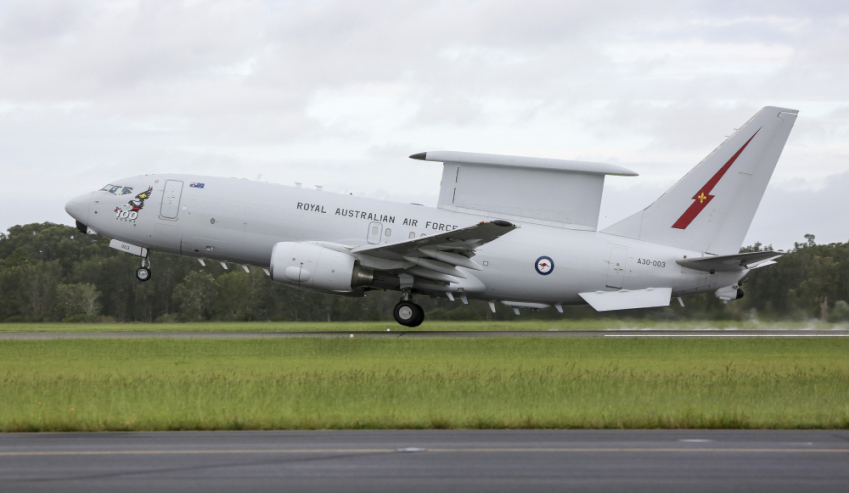The Royal Australian Air Force’s E-7A Wedgetail AEW&C aircraft has continued to impress Australian, US and Japanese aircrews and warfighters as part of Exercise Cope North in Guam.
To continue reading the rest of this article, please log in.
Create free account to get unlimited news articles and more!
During a morning sortie, up to 60 fast jets launch into the sky from Andersen Air Force Base and a No. 2 Squadron E-7A Wedgetail follows the “fight” to provide battlespace surveillance of the exercise area during Exercise Cope North missions.
The E-7A is equipped with a multi-role electronically scanned array (MESA) radar that can cover 4 million square kilometres during a single 10-hour mission.
Cope North exposes No. 2 Squadron personnel to a complex battlespace environment, providing them with familiarity in monitoring and controlling a range of different aircraft types and giving coalition partners greater understanding of the Wedgetail capability.
Surveillance and Control Officer, Flying Officer Corey Nind is working as part of a trilateral team with the US Air Force and Japan Air Self-Defense Force.
"We are conducting a large force employment exercise flying off the coast of Guam. Our role is to increase situational awareness to modern air operations, the E-7A is one of the world’s most capable airborne early warning and control platforms," FLGOFF Nind explained.
He added, "During the Exercise, the E-7A collaborates with a number of intelligence, surveillance and reconnaissance platforms to ‘build’ the battlespace picture of the exercise. We also provide a robust command and control moving aircraft in and out of the air space, as well as controlling the tactical flight and battle management."
Information and instructions provided by the E-7A crew are passed to other control agencies and aircrew participating in the exercise.
Once back on the ground, the ground support team are standing by. Aircraft Maintenance Supervisor Corporal Lucas King is part of the team that ensures that the maintenance is carried out effectively and safely.
"Working on a US air base has been awesome, everything is on a much bigger scale and they provide loads of help to the Aussies during our visit. Our team has achieved 100 per cent mission success rate which reflects really well for RAAF and demonstrates the strength of the E7 capability," CPL King added.
As an integral part of a layered ADF Air Defence System, the AEW&C capability enhances surveillance, air defence, fleet support and force co-ordination operations in defence of Australian sovereignty and national interests.
The Boeing 737 AEW&C is a state-of-the-art system providing powerful airborne surveillance, communications and battle management.
The 737 AEW&C system encompasses both the Boeing 737-700 aircraft platform and a variety of aircraft control and advanced radar systems. Consisting of components created by Boeing and Northrop Grumman, the 737 AEW&C represents the standard for future airborne early warning systems. The E-7A Wedgetail AEW&C functions include:
- A steerable beam, L-band, electronically scanned array that provides optimal performance in range, tracking and accuracy;
- Radar that can track airborne and maritime targets simultaneously;
- Assistance to the mission crew in directing the control of high-performance fighter aircraft while continuously scanning the operational area;
- A "top hat" portion that provides a practical solution for fore and aft coverage while maintaining the low drag profile of the dorsal array system – enabling the MESA system to be installed on the mid-size 737-700 platform without significant impact to aircraft performance;
- An integrated identification friend or foe (IFF) function that shares the primary radar arrays to reduce weight, improve reliability and simplify target correlation; and
- Advanced open-system architecture with standards-based design for cost-effective integration and add-on flexibility.
This announcement comes a week after Boeing consolidated $1.5 billion worth of contracts to support and enhance the capability delivered by the RAAF's E-7A Wedgetails.
Based at RAAF Base Williamtown, the six E-7A Wedgetails significantly improve the effectiveness of the ADF. They are capable of communicating with other aircraft and providing air control from the sky, and can cover 4 million square kilometres during a single 10-hour mission.
Australia, the US and Japan are committed to working together to continuously enhance common understanding, increase levels of interoperability and improve capability to provide support and assistance to regional partners.

 Login
Login







